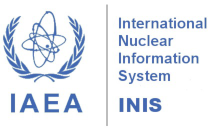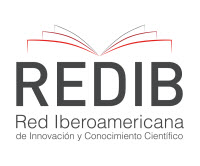Geometrical optimization of PWR spacer grids using GeN-Foam and Genetic Algorithms
DOI:
https://doi.org/10.15392/2319-0612.2024.2704Keywords:
GeN-Foam, Spacer grids, PWR, OptimizationAbstract
This paper presents the results of Computational Fluid Dynamics (CFD) oriented geometrical optimization using the GeN-Foam solver applied to subchannels of the fuel assembly in a PWR-type nuclear reactor. GeN-Foam is a coarse mesh OpenFOAM solver designed to study nuclear engineering problems involving the coupled solution of thermohydraulics, neutronics and thermomechanics. However, the solver could be used for complex geometry simulations, enabling multi-scale coupled simulations. To use GeN-Foam under these conditions, the results of the code for complex geometry simulation had to be evaluated. This assessment involved comparing the results obtained with the solver and those presented in a literature reference study. Despite the higher numerical diffusivity of the solver, this comparison demonstrated that GeN-Foam is capable of studying the fluid dynamics of fuel assemblies in nuclear reactors for both coarse and refined geometry conditions. After GeN-Foam was assessed, optimization was performed on subchannels of a fuel assembly using Genetic Algorithms (GA), evaluating the influence of geometric parameters of the spacer grids to minimize pressure drop and maximize secondary flow. Pareto Front solutions were assessed to identify a geometry that best balanced these two objectives. The optimized model showed better results than the reference study, as expected. However, the results also highlight the need to incorporate thermal physics and neutronics to ensure that the optimized solution meets the subchannel´s flow and heat exchange requirements. All tools used in this work are well-established in the literature, free, and open-source.
Downloads
References
YODER, G. L. Heat Transfer Near Spacer Grids in Rod Bundles. National Heat Transfer Conference, 1985.
SANTOS, A. A. C. dos. Investigação Numérica e Experimental do Escoamento de Água em Feixe de Varetas Representativo de Elementos Combustíveis Nucleares de Reatores do Tipo Pwr. Tese apresentada ao Programa de Pós-Graduação em Engenharia Mecânica da Universidade Federal de Minas Gerais, 2012.
KOTRAGOUDA, N. B. Application of Genetic Algorithms and CFD for Flow Control. University of Kentucky Master's Thesis, 2007.
VERSTEEG, H. K., MALALASEKERA, W. An introduction to computational fluid dynamics – The finite volume method, 2a Edição, Prentice Hall, 2007.
FIORINA, C., CLIFFORD, I., AUFIERO, M., MIKITYUK, K. GeN-Foam: a novel OpenFOAM® based multi-physics solver for2D/3D transient analysis of nuclear reactors. Nuclear Engineering and Design, vol. 294, pp. 24–37, 2015. DOI: https://doi.org/10.1016/j.nucengdes.2015.05.035
GEN-FOAM. Página do projeto no GitLab. Disponível em: <https://gitlab.com/foam-for-nuclear/GeN-Foam>. Acesso em: 21 de abril de 2023.
OPENFOAM. Página principal. Disponível em: <https://www.openfoam.com/>. Acesso em: 20 de abril de 2023.
KAROUTAS, Z., GU, C., SHOLIN B., 3-D Flow analyses for design of Nuclear Fuel Spacer. Proceedings of the 7th International Meeting on Nuclear Reactor Thermal-hydraulics NURETH-7, vol. 1, pp. 3153-3174, 1995.
CHUN, T. H., OH, D. S. A pressure drop model for spacer grids with and without flow mixing vanes, Journal of Nuclear Science and Technology, vol. 35, n. 7, pp. 508-510 (1998). DOI: https://doi.org/10.1080/18811248.1998.9733899
GILL, P. E., Murray, W., Wright, M. H. Practical Optimization. Academic Press Inc., 1981.
YANG, X. S., KOZIEL, S. Comput. Optimization, Methods and Algorithms. Studies in Computational Intelligence, 356, pp. 1-11, 2011. DOI: https://doi.org/10.1007/978-3-642-20859-1_1
MICHALEWICZ, Z. Genetic Algorithms + Data Structures = Evolution Programs. Springer-Verlag, Basel, 1992. DOI: https://doi.org/10.1007/978-3-662-02830-8
HOLLAND, J. H. Searching Nonlinear Functions for High Values. Applied Mathematics and Computation, vol. 32, pp. 255-254, 1989. DOI: https://doi.org/10.1016/0096-3003(89)90096-9
WANG, G., DING, G., LIU, R., XIE, D., WU, Y., MIAO, X. Multi-objective optimization of a bidirectional-ribbed microchannel based on CFD and NSGA-II genetic algorithm. International Journal of Thermal Sciences, vol. 181, 107731, 2022. DOI: https://doi.org/10.1016/j.ijthermalsci.2022.107731
LIU, B., HE, S., MOULINEC, C., URIBE, J. Coupled porous media approaches in sub-channel CFD. Nuclear Engineering and Design, vol. 377, 111159, 2021. DOI: https://doi.org/10.1016/j.nucengdes.2021.111159
PYTHON. Disponível em: <https://www.python.org/>. Acesso em: 10 de abril de 2023.
SALOME. SALOME PLATFORM - The open-source platform for numerical simulation. Página inicial. Disponível em: <https://www.salome-platform.org/>. Acesso em: 17 de abril de 2023.
DAKOTA. Página principal. Disponível em: < https://dakota.sandia.gov/>. Acesso em: 23 de agosto de 2024.
LAI,Y.-J., LIU T.-Y., HWANG C.-L. TOPSIS for MODM. European Journal of Operational Research, vol. 76, pp. 486-500, 1994. DOI: https://doi.org/10.1016/0377-2217(94)90282-8
Downloads
Published
Issue
Section
Categories
License
Copyright (c) 2025 Carlos Rodrigo Dias, Tiago Augusto Santiago Vieira, Andre Augusto Campagnole dos Santos, Graiciany de Paula Barros, Vitor Vasconcelos Araújo Silva, Ana Luiza Miranda Froes, Rebeca Cabral Gonçalves, Keferson de Almeida Carvalho, Higor Fabiano Pereira de Castro

This work is licensed under a Creative Commons Attribution 4.0 International License.
Licensing: The BJRS articles are licensed under a Creative Commons Attribution 4.0 International License, which permits use, sharing, adaptation, distribution and reproduction in any medium or format, as long as you give appropriate credit to the original author(s) and the source, provide a link to the Creative Commons license, and indicate if changes were made. The images or other third party material in this article are included in the article’s Creative Commons license, unless indicated otherwise in a credit line to the material. If material is not included in the article’s Creative Commons license and your intended use is not permitted by statutory regulation or exceeds the permitted use, you will need to obtain permission directly from the copyright holder. To view a copy of this license, visit http://creativecommons.org/licenses/by/4.0/






















